Like Dorothy discovering Oz wasn’t so different from Kansas, you’ll find that southern New Jersey’s Pine Barrens ecosystem offers surprisingly familiar yet unique gardening opportunities. You’re working with acidic, sandy soil that drains quickly, creating conditions where most conventional plants struggle. However, native species have spent centuries adapting to these harsh conditions, developing remarkable drought tolerance and pest resistance. The key lies in understanding which plants will transform your challenging landscape into a thriving, low-maintenance garden that supports local wildlife year-round.
Contents
- 1 Pine Barrens Ecosystem Characteristics
- 2 Vibrant Wildflowers for Gardens
- 3 Pine Barrens Oak Species
- 4 Drought-Tolerant Native Shrubs
- 5 Selecting the Right Native Plants for Your Garden
- 6 Frequently Asked Questions
- 6.1 When Is the Best Time to Plant Native Species in Southern New Jersey?
- 6.2 How Do I Propagate Native Plants From Seeds or Cuttings at Home?
- 6.3 What Native Plants Attract Butterflies and Hummingbirds to My Garden?
- 6.4 How Much Do Native Plants Typically Cost Compared to Non-Native Varieties?
- 6.5 Which Native Plants Are Deer-Resistant for Problem Areas in My Yard?
Pine Barrens Ecosystem Characteristics
When you venture into southern New Jersey’s Pine Barrens, you’re stepping into one of the most unique ecosystems on the East Coast. This sprawling wilderness covers over one million acres of surprisingly diverse terrain.
The pine barrens ecology thrives on challenging conditions that would defeat most plant communities. You’ll find acidic, nutrient-poor soils that locals call “sugar sand.” This soil composition drains rapidly, creating drought-like conditions even after heavy rains.
Despite these harsh conditions, the ecosystem supports over 800 plant species. Fire plays a significant role here, with many plants actually depending on periodic burns for reproduction and survival. The ecosystem flows into coastal estuaries, creating important transitional habitats that further enhance the region’s biodiversity.
Vibrant Wildflowers for Gardens
Southern New Jersey’s native wildflowers offer stunning garden displays while supporting local ecosystems. These resilient species thrive in diverse conditions from sunny meadows to shaded woodlands throughout growing seasons. Eastern Columbine showcases distinctive red and yellow blooms during late spring, creating eye-catching focal points in naturalized garden settings.
Wild Bergamot (Monarda Fistulosa)

Wild Bergamot is a stunning native perennial that brings vibrant lavender-pink blooms to Southern New Jersey gardens from late spring through early fall. This herbaceous wildflower grows 2-5 feet tall, forming attractive clumps through spreading rhizomes. Its aromatic, gray-green foliage releases a pleasant minty fragrance when brushed against, while the showy clustered flowers serve as magnets for butterflies, native bees, and hummingbirds.
Beyond its ornamental appeal, Wild Bergamot offers exceptional drought tolerance once established and deer resistance due to its aromatic oils. This adaptable native thrives in various soil conditions and naturalizes beautifully in wildflower meadows, prairie gardens, and informal landscapes. Its traditional uses include herbal teas and medicinal applications, making it both beautiful and functional in the garden setting. The plant produces brown nutlets as fruit, which ripen approximately two months after the blooming period ends.
- Hardiness: Zones 3-9, native throughout North America including New Jersey
- Light: Full sun preferred for best flowering and disease resistance
- Water: Moderately moist to dry; drought tolerant once established
- Soil: Adaptable to various soil types; prefers rich, well-draining, calcareous soils
- Fertilizer: Low maintenance; typically does not require supplemental feeding
- Pest/Disease Resistance: Resistant to powdery mildew with good air circulation; deer resistant
- Growth Rate: Moderate; spreads via rhizomes to form colonies over time
Wild Columbine (Aquilegia Canadensis)
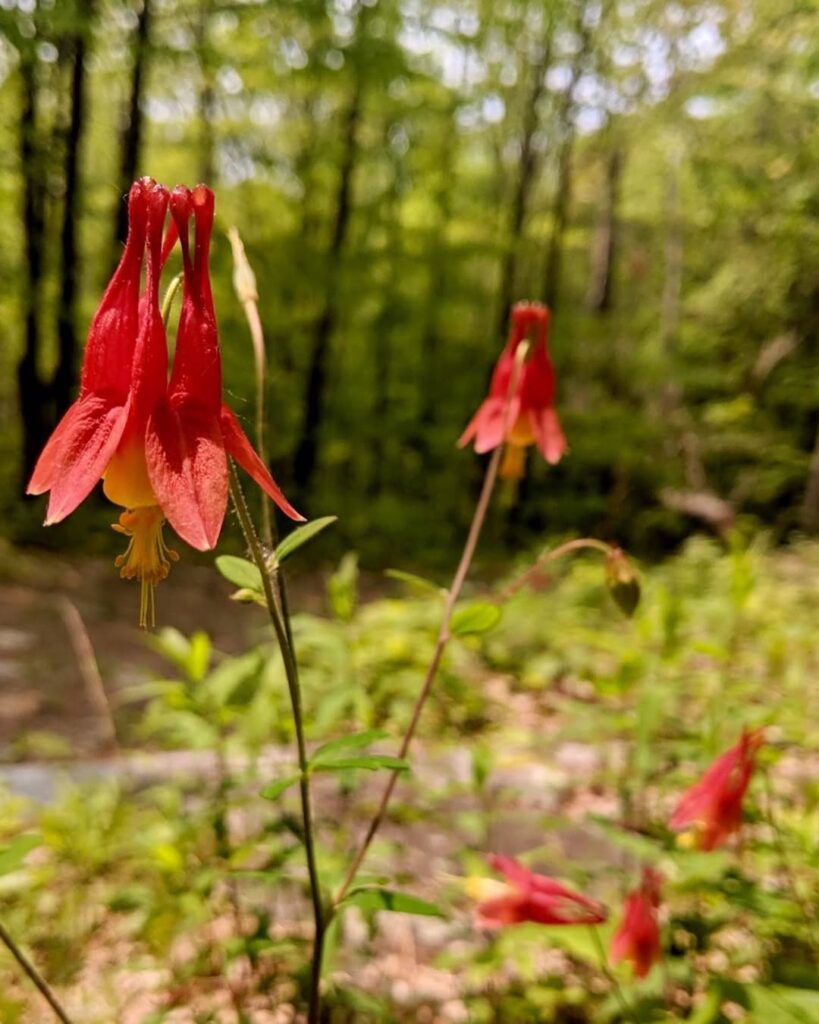
Wild Columbine is a charming native herbaceous perennial that brings delicate beauty to Southern New Jersey gardens. Growing 1 to 2.5 feet tall, this wildflower produces distinctive bell-like flowers in red and yellow that dangle gracefully from slender stems above blue-green ternately compound leaves. The plant forms attractive clumps and blooms from March through July, with peak flowering occurring in May and June.
This versatile native excels in various garden settings, from shade gardens to naturalized areas and rock gardens. Wild Columbine readily self-seeds in favorable conditions, creating sustainable populations that support local wildlife. The flowers attract hummingbirds and long-tongued insects, while the plant serves as a host for certain butterfly species, making it valuable for pollinator gardens. The genus name Aquilegia is derived from Latin meaning eagle, referencing the distinctive flower spurs.
- Hardiness: USDA zones 3-8
- Light: Partial shade preferred; tolerates full sun with adequate moisture
- Water: Dry to medium moisture; requires good drainage
- Soil: Well-drained loam, sand, or clay; neutral pH preferred; avoid overly rich soils
- Fertilizer: Low requirements; rich soil may weaken stems
- Pest/Disease Resistance: Deer-resistant; generally pest-free
- Growth Rate: Moderate; self-seeds freely in favorable conditions
New Jersey Aster (Symphyotrichum Novi-Belgii)
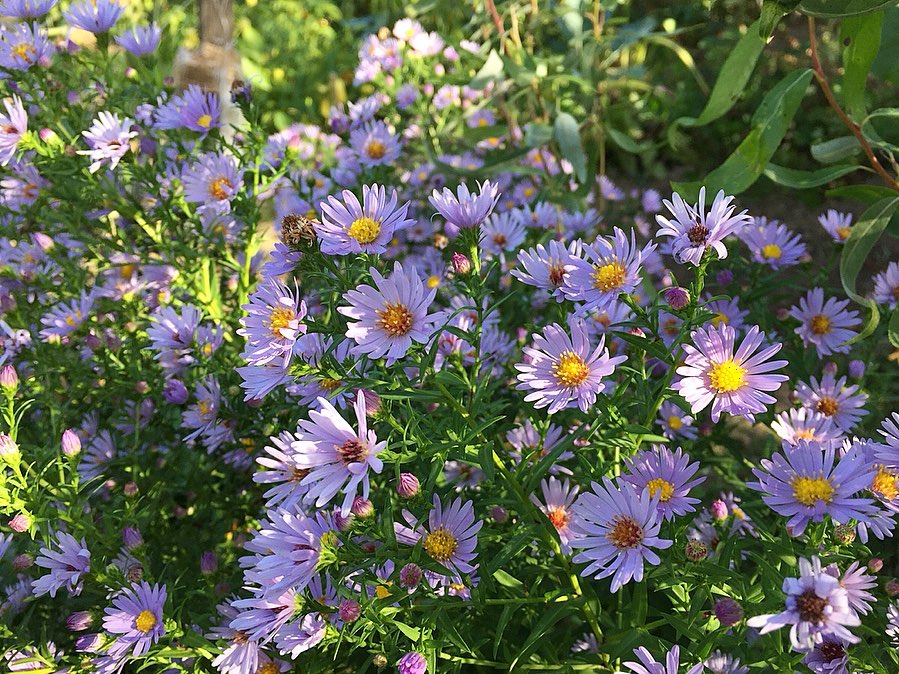
New Jersey Aster is a striking perennial wildflower native to southern New Jersey’s moist meadows and stream banks. This robust plant produces masses of vibrant violet to deep purple, daisy-like flowers with bright yellow centers from August through October, providing essential late-season nectar when few other natives bloom. Growing 3-6 feet tall with lance-shaped, rough-textured leaves, it forms dense, eye-catching clumps that support migrating Monarchs and diverse pollinators.
Once established, New Jersey Aster requires minimal maintenance while delivering maximum ecological impact. Its adaptability to various soil types and tolerance for periodic flooding make it excellent for rain gardens and naturalized borders. The plant pairs beautifully with goldenrod and native grasses, creating dynamic autumn displays that extend the garden’s seasonal interest well into fall. Taller specimens may require staking support to maintain their upright structure, especially in windy locations.
- Hardiness: Zones 4-8, perennial in southern New Jersey
- Light: Full sun preferred, tolerates partial shade (minimum 6 hours sunlight)
- Water: Consistent moisture required, tolerates periodic flooding but not prolonged drought
- Soil: Moist, rich, well-drained preferred; adaptable to sandy and clay soils
- Fertilizer: Not typically required in rich soils
- Pest/Disease Resistance: Good with proper spacing and air circulation; avoid waterlogged conditions
- Growth Rate: Moderate to fast, reaches 3-6 feet at maturity
Pink Lady Slipper Orchid

The Pink Lady Slipper orchid is one of North America’s most distinctive native wildflowers, featuring an unmistakable pink, pouch-shaped bloom that gives it its common name. This large native orchid species can grow up to 3 feet tall and produces 1-3 striking flowers per stalk during its blooming period from May through August.
While challenging to cultivate, this remarkable orchid thrives in its natural woodland habitat throughout the northeastern United States, including New Jersey. The plant’s glandular hairs can cause skin irritation similar to poison ivy, so careful handling is recommended when observing these beautiful specimens in the wild. Known scientifically as Cypripedium acaule, the specific epithet “acaule” refers to its characteristic lack of an obvious stem.
- Hardiness: Zones 2-7, native to northeastern North America including New Jersey
- Light: Partial shade, thrives under conifer and mixed hardwood forests
- Water: Moderate moisture in well-drained sites, tolerates dry to mesic conditions
- Soil: Acidic, well-drained woodland soil, difficult to transplant from native habitat
- Fertilizer: None required, adapted to natural forest floor conditions
- Pest/Disease Resistance: Generally resistant when grown in appropriate native conditions
- Growth Rate: Slow-growing perennial requiring specific conditions for establishment
Swamp Rose Mallow (Hibiscus)
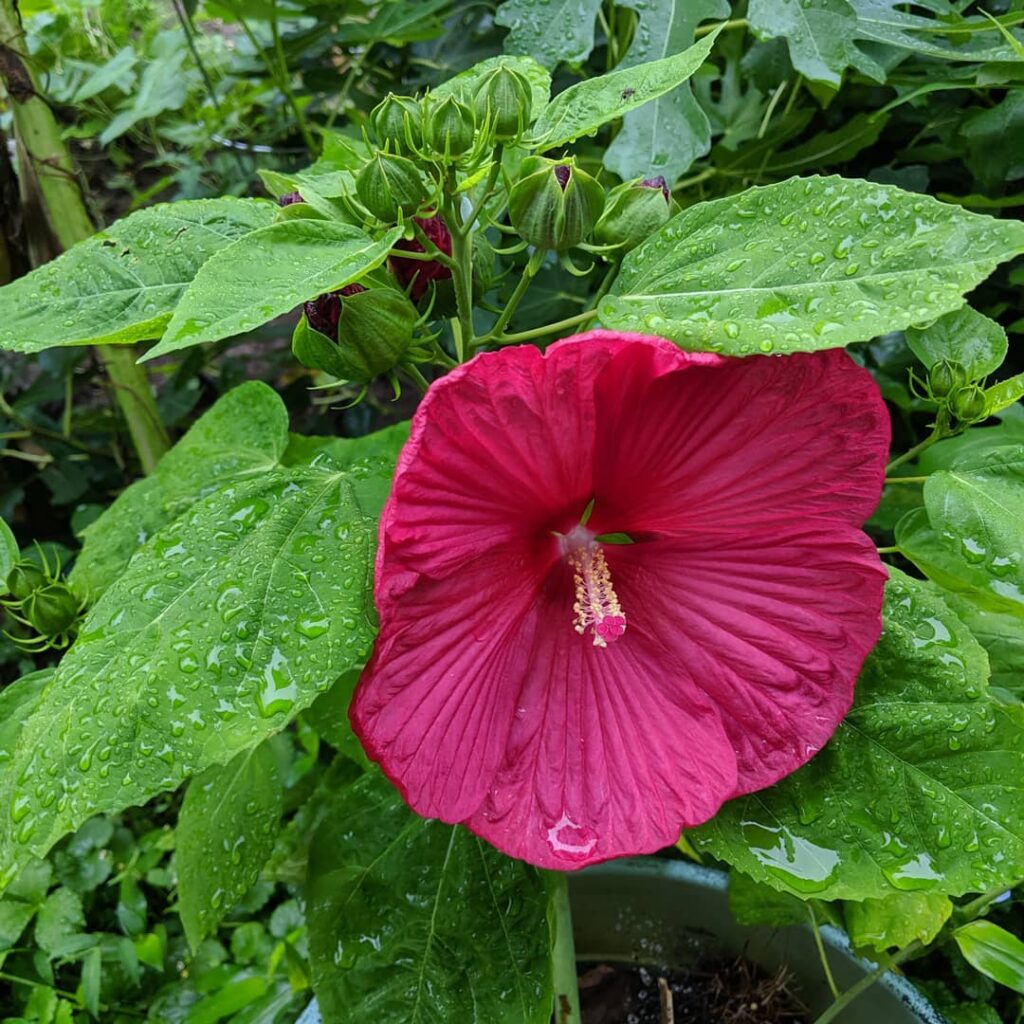
Swamp Rose Mallet is a stunning native wildflower that brings tropical flair to New Jersey gardens. This shrubby perennial produces massive 4-7 inch blooms in white or pink with striking red centers from July through September. Growing 3-8 feet tall with distinctive heart-shaped leaves, it creates an impressive specimen plant while supporting local pollinators.
This hardy native thrives in challenging wet conditions where many garden plants fail, making it perfect for rain gardens, pond edges, and wetland areas. Its late-summer blooms provide essential nectar when few other flowers are available, attracting hummingbirds, bees, and butterflies to the landscape. The plant features smooth on top leaves that are distinctively hairy underneath, adding textural interest to the garden.
- Hardiness: Cold hardy perennial, withstands southern New Jersey winters
- Light: Full sun preferred, tolerates partial shade
- Water: Moist to wet soil conditions, thrives in consistently damp areas
- Soil: Tolerates both sandy and clay substrates, prefers slightly acidic to acidic pH
- Fertilizer: Low maintenance once established, minimal fertilizer requirements
- Pest/Disease Resistance: Generally resistant, few serious pest or disease issues
- Growth Rate: Moderate growth rate, establishes well in suitable wet locations
Pine Barrens Oak Species
Pine Barrens oak species thrive in the region’s challenging sandy, acidic soils. We’ll explore Bear Oak, Black Oak, and Southern Red Oak, plus their essential ecological contributions. These oaks reproduce by dropping acorns, which provide food for wildlife and germinate more easily in thick ground cover than pine seeds.
Dwarf Chestnut Oak
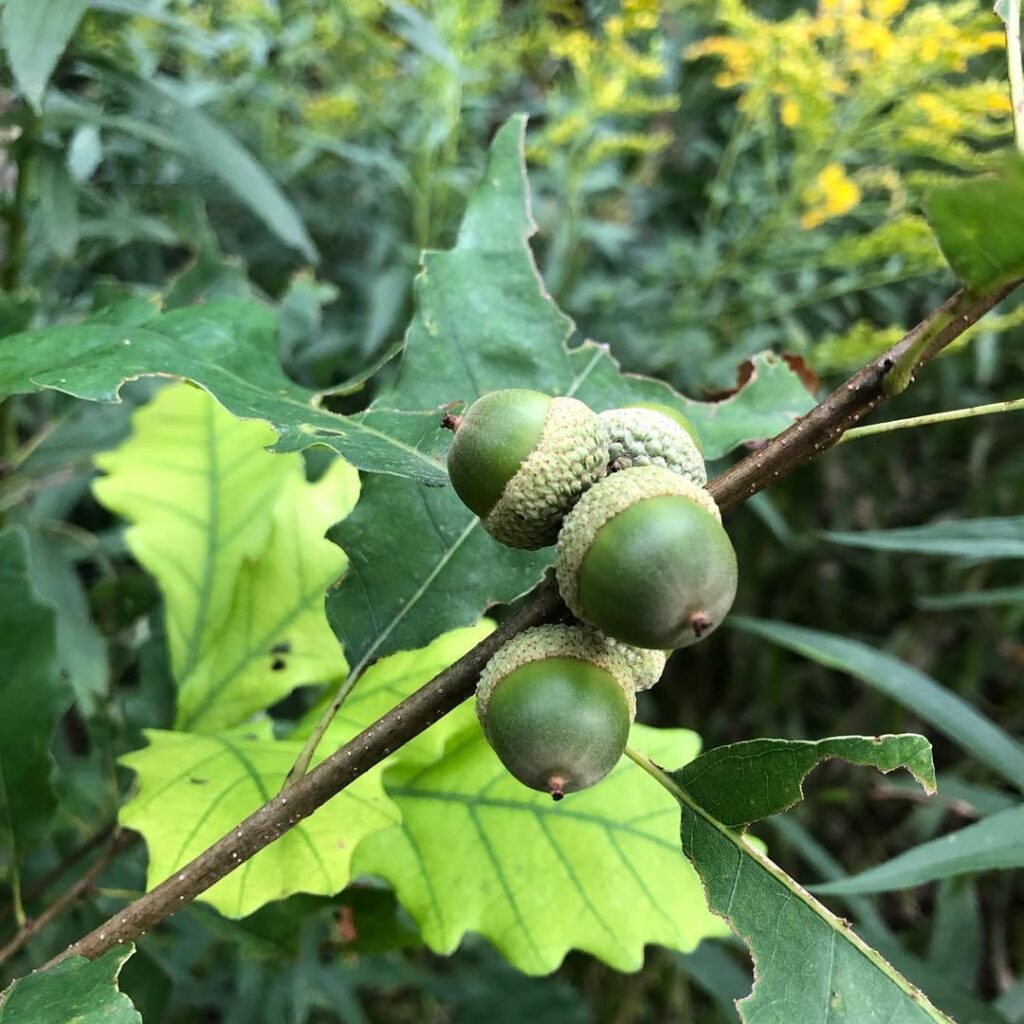
The Dwarf Chestnut Oak is a resilient native shrub to small tree that thrives in the challenging Pine Barrens ecosystem of southern New Jersey. Growing 3-25 feet tall, it features leathery, dark green leaves and produces reliable annual acorn crops that support local wildlife. This hardy species spreads through underground rhizomes, forming stabilizing colonies in dry, sandy soils.
Adapted to fire-prone environments, the Dwarf Chestnut Oak serves as an excellent choice for restoration projects and naturalized landscaping. Its deep taproot and tolerance for poor, acidic soils make it invaluable for erosion control, though transplanting established specimens can be challenging due to the extensive root system. The species can produce acorns at a very young age, making it particularly valuable for wildlife habitat establishment.
- Hardiness: USDA Zones 5-9
- Light: Full sun
- Water: Low to moderate; drought tolerant once established
- Soil: Acidic, sandy, rocky, or nutrient-poor soils; excellent drainage required
- Fertilizer: None needed; adapted to nutrient-poor conditions
- Pest/Disease Resistance: High; minimal issues
- Growth Rate: Slow to moderate
Blackjack Oak (Quercus Marilandica)
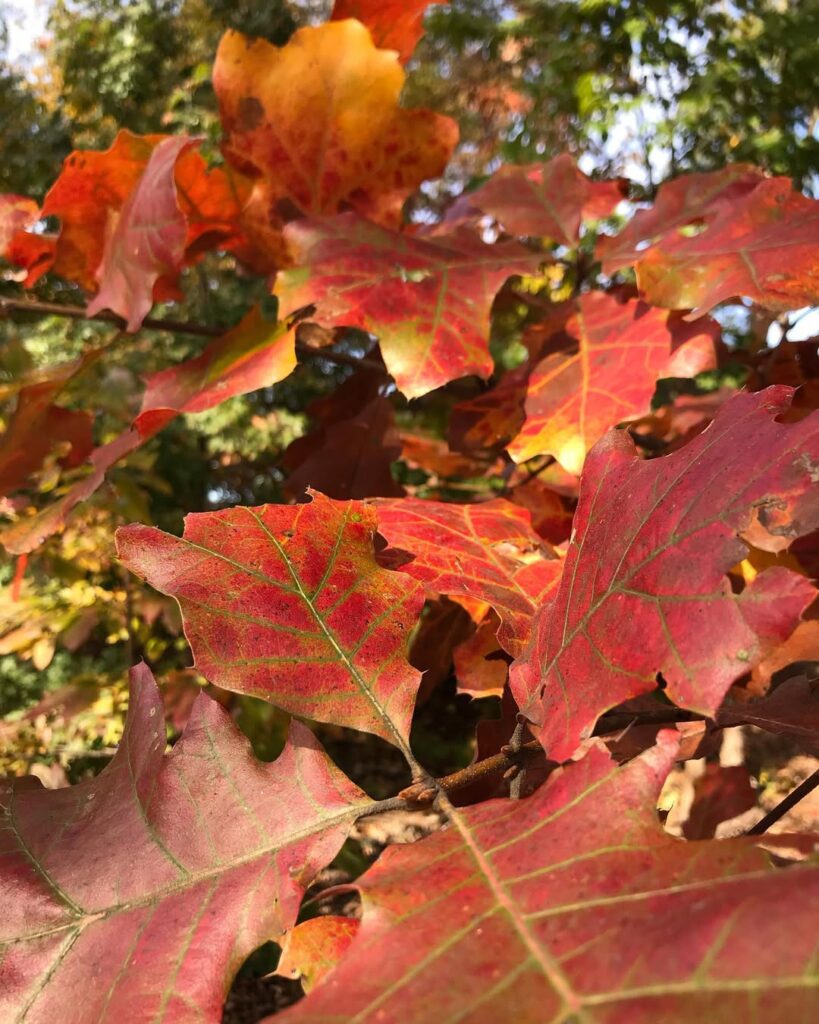
Blackjack Oak is a small to medium-sized deciduous oak native to New Jersey and much of the eastern United States. This resilient tree typically reaches 20-40 feet tall with distinctive wedge-shaped leaves that are widest at the tip and feature 3-5 shallow, bristle-tipped lobes. The dark green leaves have rusty-brown, hairy undersides and turn yellowish-brown in fall.
What makes Blackjack Oak particularly valuable for challenging landscapes is its exceptional tolerance of poor, dry conditions where other trees struggle to survive. The tree’s distinctive blackish bark resembles alligator hide with square blocks, and it produces oblong acorns that provide important wildlife food. Its irregular, rounded crown and tendency to retain some leaves through winter add visual interest to naturalistic plantings. This oak serves as a host plant for numerous butterfly species and supports a wide variety of Lepidopteran larvae.
- Hardiness: Zones 6-9
- Light: Full sun to partial shade
- Water: Drought tolerant once established; prefers dry to moderately dry conditions
- Soil: Adaptable to poor, sandy, clay, or rocky soils; prefers well-drained, acidic soil
- Fertilizer: None required; adapted to nutrient-poor soils
- Pest/Disease Resistance: Generally resistant to most pests and diseases
- Growth Rate: Slow to moderate
Post Oak (Quercus Stellata)
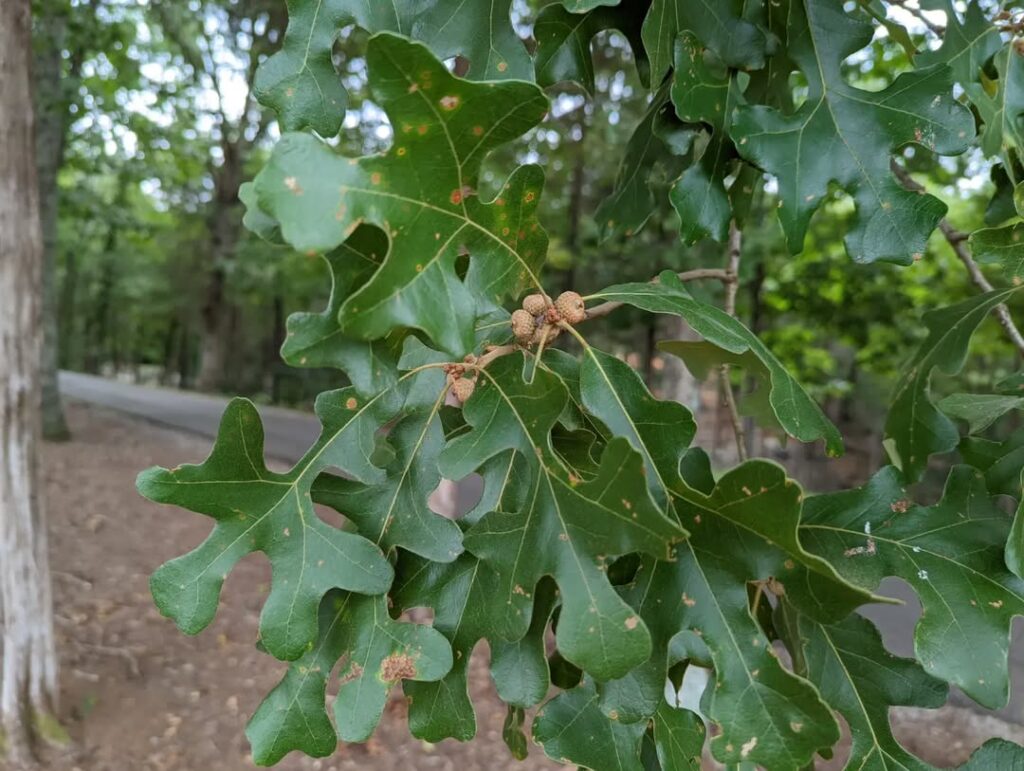
Post Oak (Quercus stellata) is a distinctive deciduous tree native to the Pine Barrens region, characterized by its unique cross-shaped lobed leaves and impressive longevity of 300-400 years. Growing 50-60 feet tall with dense, oval crowns, this slow-growing oak produces egg-shaped acorns that mature in one season and serve as an important wildlife food source.
Exceptionally adapted to challenging conditions, Post Oak thrives in poor soils and drought-prone environments where other species struggle. Its durable wood has historically been valued for fence posts and construction, while ecologically it provides essential habitat and contributes to forest biodiversity in changeover zones between forests and prairies. The species supports a remarkable diversity of wildlife, with its acorns serving as food and tree cavities in older specimens providing crucial nesting sites for birds and mammals.
- Hardiness: Zones 5-9, extremely drought tolerant and resilient to harsh conditions
- Light: Full sun to partial shade
- Water: Low to moderate water needs once established, highly drought resistant
- Soil: Adapts to poor, dry soils with good drainage; thrives in sandy, rocky, or clay soils
- Fertilizer: Generally not required, adapted to nutrient-poor conditions
- Pest/Disease Resistance: Good resistance to most pests and diseases, though susceptible to some insect damage
- Growth Rate: Slow growing, begins acorn production around 25 years of age
Scrub Oak (Quercus Ilicifolia)

Scrub Oak is a hardy deciduous shrub native to the Eastern United States, particularly thriving in New Jersey’s Pine Barrens region. This member of the red oak group forms dense thickets reaching 3-30 feet tall with a distinctive gangly, spreading growth habit. Its holly-like leaves with spiny margins create unique visual interest throughout the growing season.
Known for its exceptional adaptability to challenging conditions, Scrub Oak serves as an important wildlife habitat and food source. The plant produces yellow-green catkins in spring and displays attractive fall coloration. Its ability to hybridize with other oak species like blackjack oak contributes to forest biodiversity and ecosystem stability across its native range. This oak species serves as the primary or sole larval host for 29% of rare or endangered Lepidopterans in southern New England and southeastern New York.
- Hardiness: USDA zones 5-9, native to Eastern United States from southern Maine to eastern Ohio
- Light: Full sun to partial shade
- Water: Low to medium moisture requirements, medium drought tolerance
- Soil: Sandy, acidic soils with medium to coarse texture, dry uplands preferred
- Fertilizer: Minimal requirements, adapted to nutrient-poor soils
- Pest/Disease Resistance: Generally resistant, typical oak vulnerabilities may apply
- Growth Rate: Moderate, forms dense thickets over time
Sand Live Oak
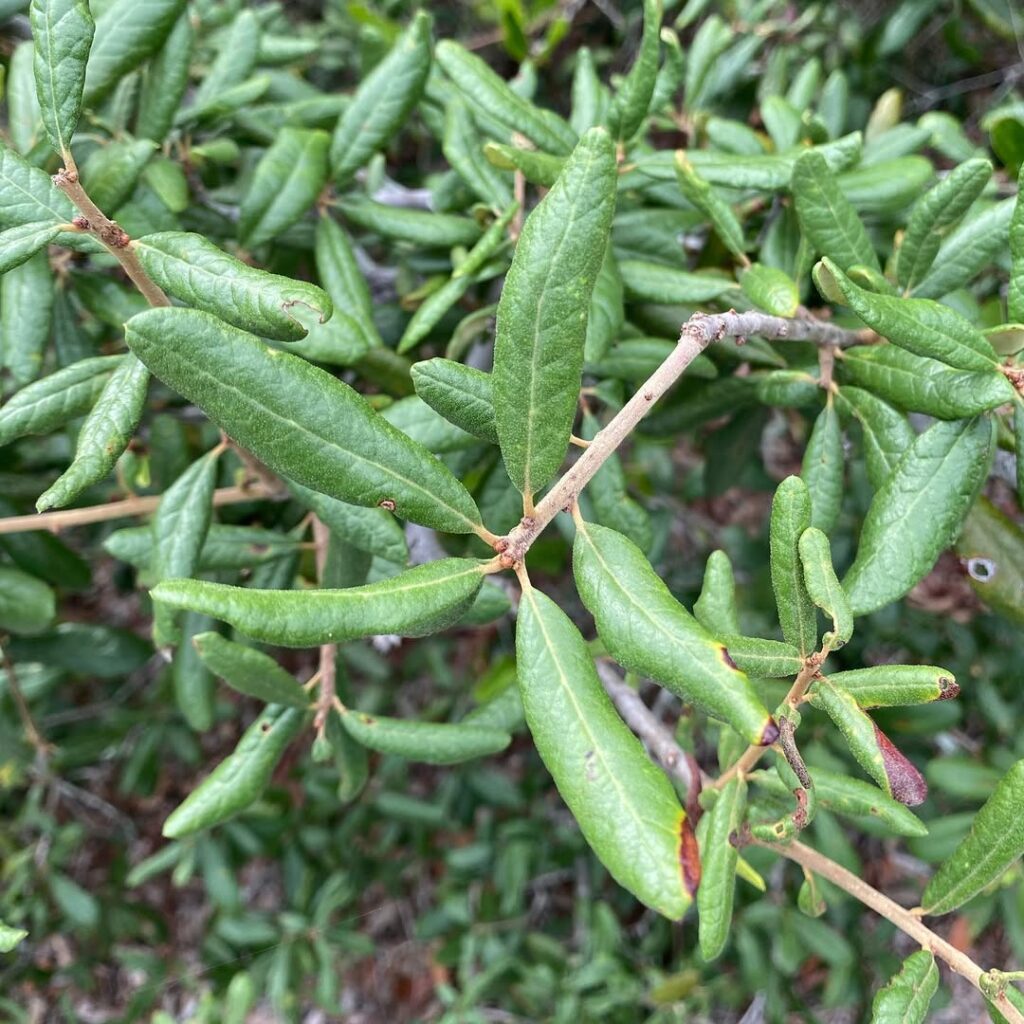
Sand Live Oak is a remarkably adaptable native tree that typically reaches 50 feet in height with a broad, often arching growth habit. Its distinctive 2-inch waxy leaves have a unique canoe shape, while the dark, deeply furrowed bark provides visual interest year-round. This scrubby tree forms natural thickets and is exceptionally valuable for coastal landscapes due to its outstanding salt and drought tolerance.
The species demonstrates incredible resilience, surpassing even Southern Live Oak in salt tolerance while adapting well to construction-disturbed sites. Its ability to compartmentalize decay and resprout from roots after fire damage makes it particularly durable. The tree produces paired acorns that support wildlife and serves as a butterfly host plant, contributing considerably to scrub habitat ecosystems throughout its native range. The tree hosts Imperial moth larvae, which appear from April through October as part of its significant wildlife value.
- Hardiness: Zones 8-10
- Light: Full sun to partial shade
- Water: Drought tolerant once established; prefers moist conditions initially
- Soil: Well-drained; adaptable to sand, loam, or clay; tolerates alkaline conditions
- Fertilizer: Low requirements; thrives in poor soils
- Pest/Disease Resistance: Good compartmentalization of decay; generally resistant
- Growth Rate: Moderate to slow
Drought-Tolerant Native Shrubs
Drought-tolerant native shrubs offer sustainable landscaping solutions with minimal water requirements. These resilient species provide key habitat benefits, specific growing requirements, diverse applications, and unique adaptations for challenging conditions. Many varieties are safe for children and pets, making them ideal choices for family-friendly gardens and residential landscapes.
Bayberry (Myrica Pensylvanica)
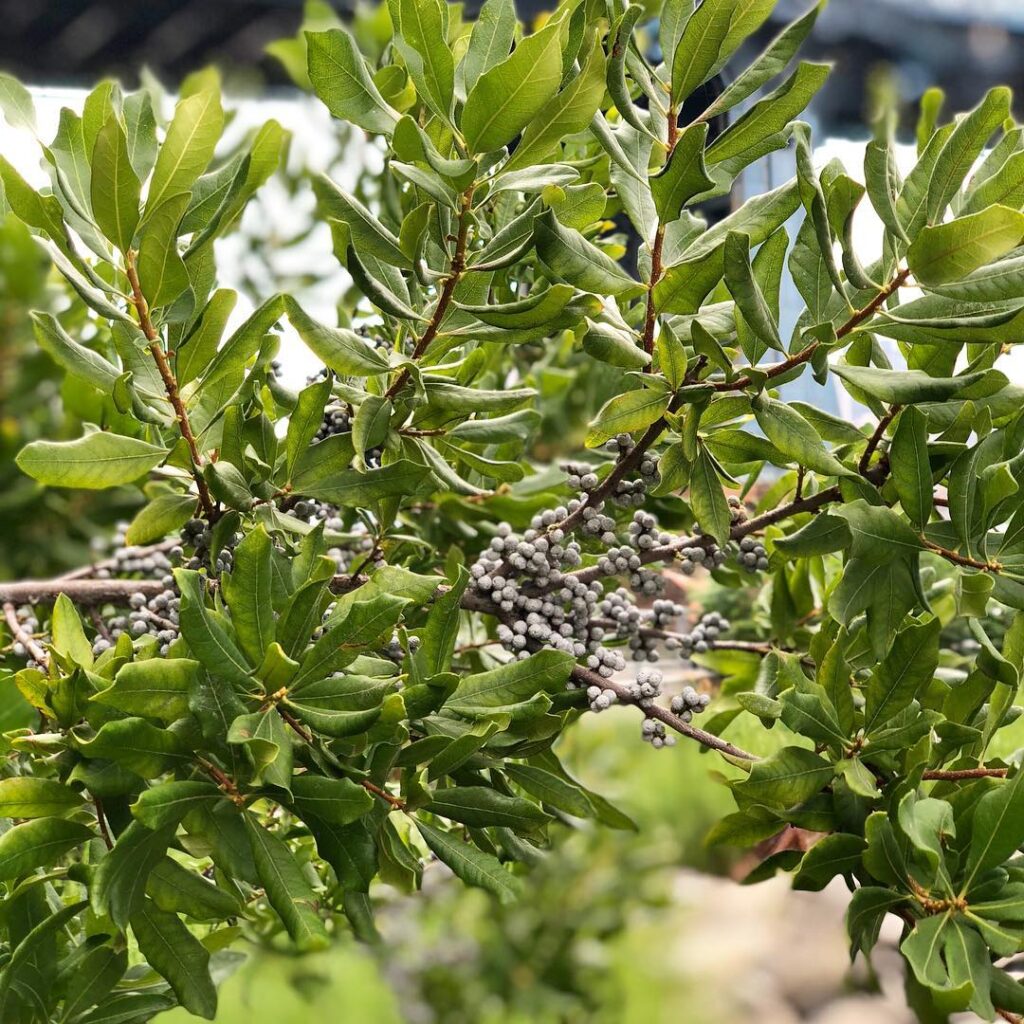
Bayberry is a multi-stemmed native shrub reaching 6-12 feet in height with an open, rounded form often wider than tall. This resilient plant features glossy, dark green aromatic leaves and produces distinctive gray-white waxy berries that persist through winter, providing valuable food for birds. Its smooth light grey bark and horizontal branching pattern create year-round visual interest.
Exceptionally well-suited for coastal Southern New Jersey, bayberry demonstrates remarkable tolerance for environmental stresses including salt spray, drought, and poor soils. The plant forms beneficial relationships with soil bacteria to fix nitrogen, reducing fertility requirements. Its slow growth rate and irregular silhouette require occasional pruning to maintain structure, but this hardy native excels as a specimen plant or informal hedge. As a member of the Myricaceae family, bayberry shares characteristics with other aromatic shrubs in this distinctive botanical group.
- Hardiness: Well-adapted to Southern New Jersey coastal conditions with excellent environmental stress tolerance
- Light: Full sun to partial shade
- Water: Drought tolerant once established; minimal watering requirements
- Soil: Tolerates poor, sandy, and compacted soils; excellent salt tolerance for coastal areas
- Fertilizer: Low requirements due to nitrogen-fixing root nodules formed with Frankia bacteria
- Pest/Disease Resistance: Generally resistant with good natural defenses
- Growth Rate: Slow with irregular growth pattern
Inkberry Holly (Ilex Glabra)
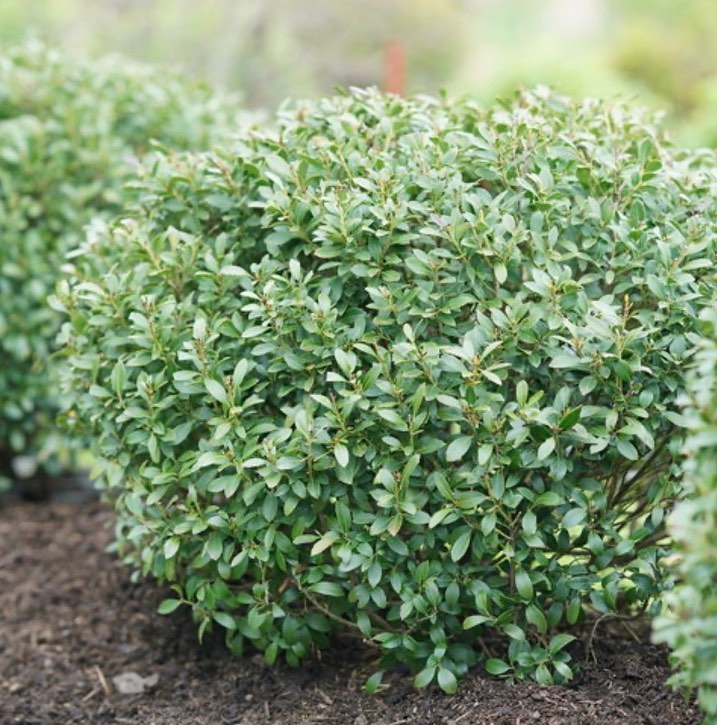
Inkberry Holly (Ilex glabra) is a versatile evergreen shrub native to the Eastern United States, perfectly suited for Southern New Jersey landscapes. This hardy plant typically grows 5-8 feet tall and wide, forming dense colonies through natural suckering. Its glossy, dark green foliage provides year-round interest while supporting local wildlife with nectar-rich flowers and small black berries. The shrub serves as a valuable larval host plant for Henry’s Elfin butterfly, enhancing biodiversity in native garden settings.
Historically known as “Appalachian tea” by Native Americans, inkberry holly serves as an excellent native alternative to boxwood in formal landscapes. The shrub demonstrates remarkable adaptability to various soil conditions and environmental stresses, making it ideal for coastal areas, wetland restoration, and urban settings where resilience is essential.
- Hardiness: USDA zones 5-10
- Light: Full sun to partial shade
- Water: Drought tolerant once established; adaptable to both moist and dry conditions
- Soil: Wide tolerance including sandy, clay, wet, and acidic soils (pH 3.5-6.0); prone to chlorosis in alkaline conditions
- Fertilizer: Minimal requirements; thrives in native soil conditions
- Pest/Disease Resistance: Generally pest and disease free; good deer resistance
- Growth Rate: Moderate growth rate with natural mounded form
Spicebush (Lindera Benzoin)
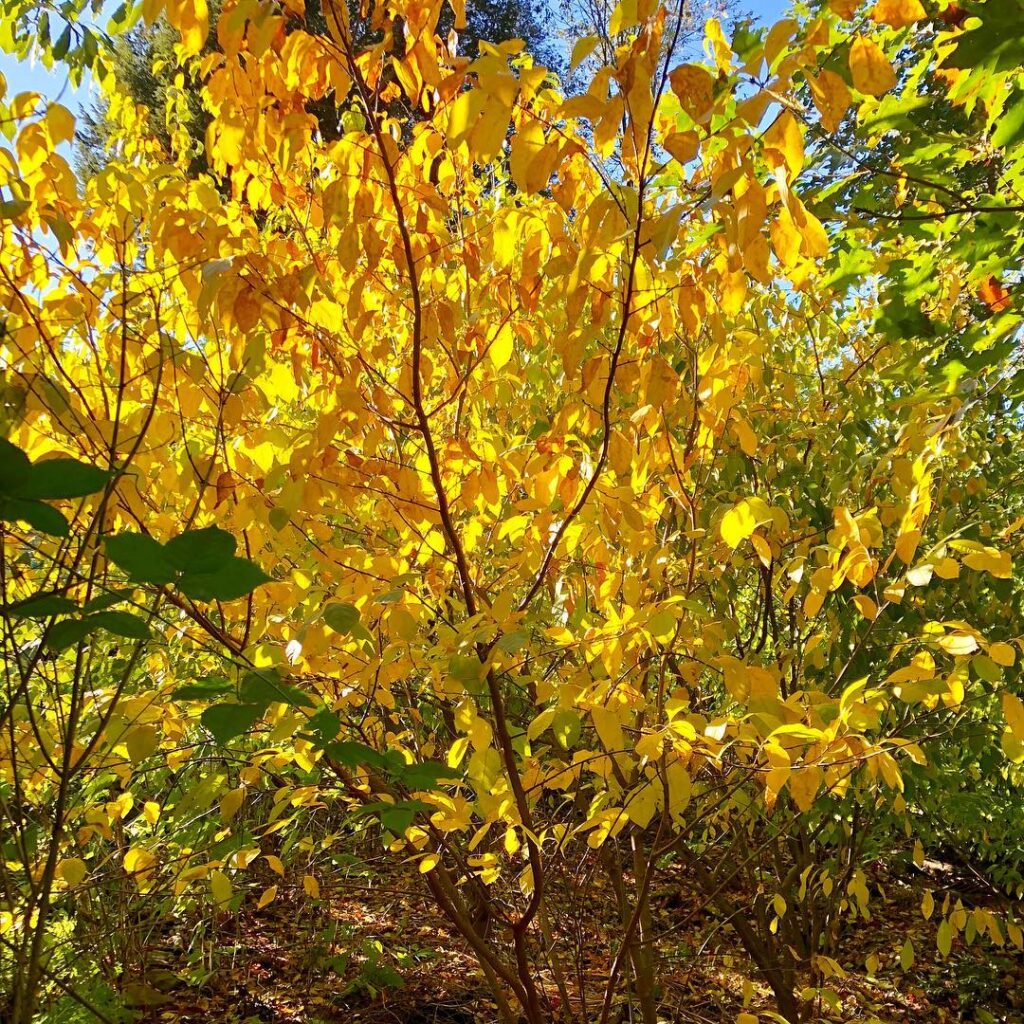
Spicebush (Lindera benzoin) is a versatile deciduous shrub native to eastern North America, including South Jersey’s Pine Barrens region. Growing 6-15 feet tall, this woodland understory plant produces fragrant yellow flowers in early April before its leaves emerge, followed by glossy red berries that persist through fall.
This ecologically valuable shrub serves as a host plant for spicebush swallowtail butterflies while providing essential nectar for early pollinators and food for birds. Its aromatic foliage turns golden-yellow in autumn, making it an excellent choice for naturalized areas, woodland gardens, and rain gardens where it thrives in moist, shaded conditions. Spicebush is a dioecious shrub, meaning individual plants are either male or female, with only female plants producing the attractive red berries.
- Hardiness: Zones 4-9, well-adapted to South Jersey climate
- Light: Partial shade to full shade, adaptable to various light conditions
- Water: Consistently moist soil required, tolerates seasonal flooding up to 25% of growing season
- Soil: Various soil types including sandy and loam, pH 5.0-8.0
- Fertilizer: Low maintenance, typically does not require supplemental fertilization
- Pest/Disease Resistance: Generally pest and disease free, may experience variable deer browsing
- Growth Rate: Moderate growth rate, reaching mature size of 6-15 feet
Sweet Pepperbush (Clethra Alnifolia)
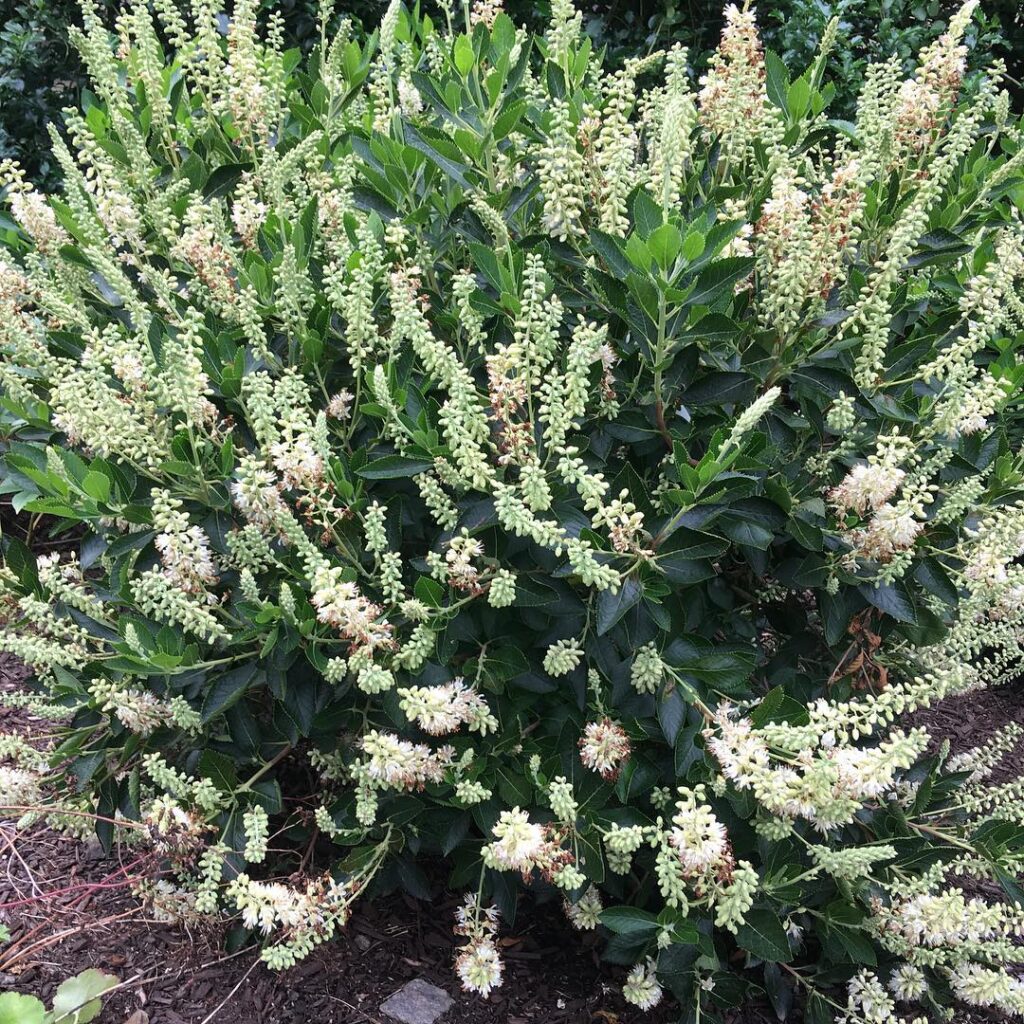
Sweet Pepperbush is a versatile native shrub that typically grows 3-8 feet tall with a densely rounded, mounded habit. This deciduous plant produces spectacular fragrant white or pink flower clusters in July and August when few other natives bloom, making it invaluable for late-season pollinators. The shrub offers outstanding fall foliage color and persistent brown seed capsules that provide winter food for birds.
Despite its preference for moist, acidic soils, Sweet Pepperbush demonstrates remarkable adaptability once established. It tolerates both drought periods and flooding, thrives in full sun to deep shade, and maintains its blooming capability even in heavily shaded locations. This low-maintenance shrub works excellent as screening, borders, or specimen plantings while supporting biodiversity through its wildlife value. The plant shows exceptional resilience with its soil compaction tolerance and ability to rebound from fire damage.
- Hardiness: Zones 3-9, tolerates temperatures to -22°F (-30°C)
- Light: Full sun to deep shade, blooms well in all conditions
- Water: Prefers consistent moisture but tolerates drought and flooding once established
- Soil: Moist, acidic, organic-rich soils preferred; adapts to average soils
- Fertilizer: No supplemental fertilization typically needed
- Pest/Disease Resistance: Deer resistant, generally pest and disease free
- Growth Rate: Moderate growth rate, responds well to pruning
Aronia Berry (Chokeberry)
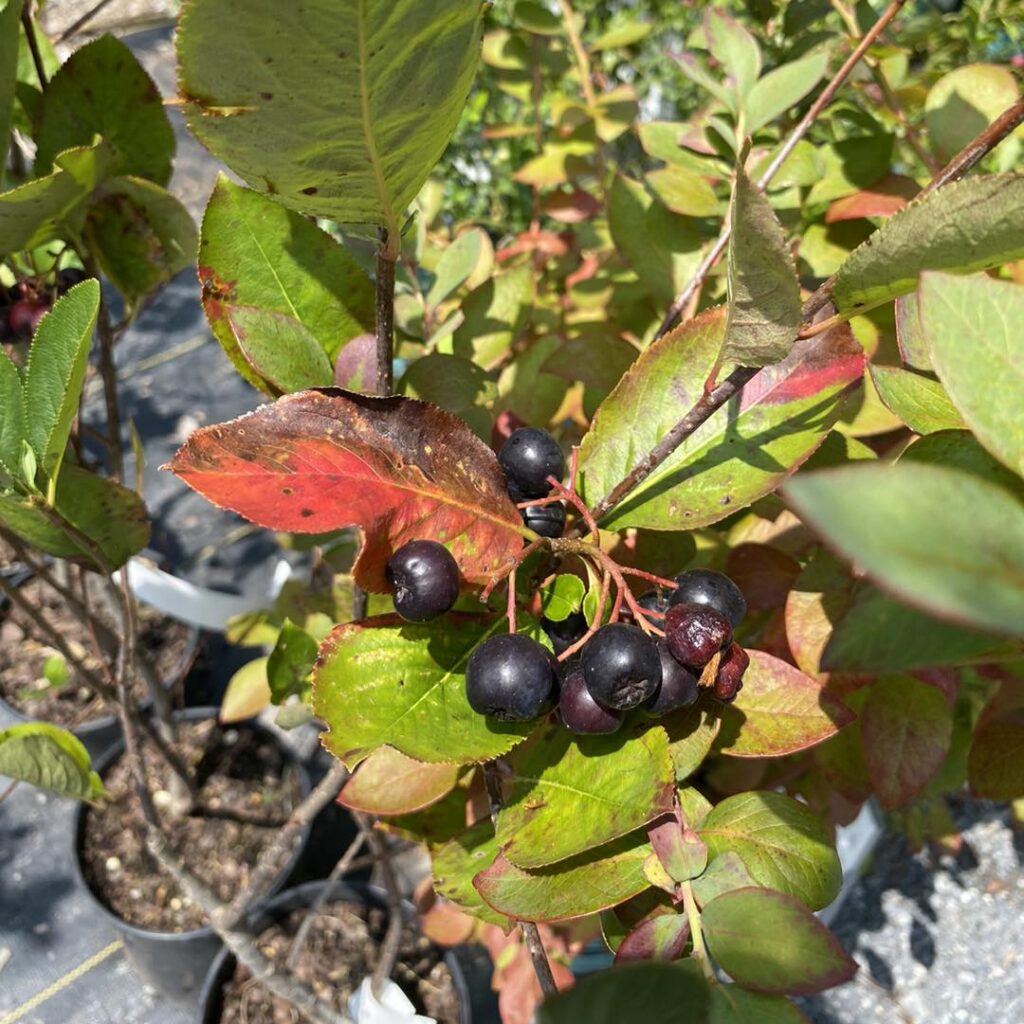
Aronia, commonly known as chokeberry, is a resilient multi-stemmed deciduous shrub native to eastern North America. Growing 4-8 feet tall with a vase-shaped form, it produces clusters of showy white flowers in spring followed by persistent berries that provide winter interest. Black chokeberry (Aronia melanocarpa) features glossy green leaves with brilliant fall color and purplish-black fruit, while red chokeberry (Aronia arbutifolia) has a more open structure with red berries. Black chokeberry is considered more user-friendly than its red-fruiting relative, offering a smaller and more aesthetically pleasing form.
This adaptable shrub excels in challenging landscape conditions, particularly wet areas where other plants struggle. The edible but astringent berries persist through winter, supporting wildlife while adding visual appeal. Chokeberry works well in naturalistic plantings, rain gardens, and shrub borders, offering multi-season interest and ecological benefits as part of native plant communities.
- Hardiness: USDA zones 3-7, extremely cold-hardy
- Light: Full sun to partial shade
- Water: Thrives in moist to wet conditions, tolerates occasional drought once established
- Soil: Adaptable to various soil types, performs well in wet areas, may show chlorosis in alkaline soils
- Fertilizer: Low maintenance, typically requires no supplemental fertilization
- Pest/Disease Resistance: Excellent resistance to common pests and diseases
- Growth Rate: Moderate growth rate, reaching mature size in 3-5 years
Selecting the Right Native Plants for Your Garden
How do you choose the perfect native plants when you’re facing over 2,000 species identified by the Native Plant Society in New Jersey? Start your native plant selection by evaluating your garden’s sun exposure first. Full sun, partial shade, or full shade conditions will narrow your choices considerably.
Next, assess your soil moisture levels. Arrowwood Viburnum tolerates dry to wet conditions, while Winterberry Holly prefers consistently moist soil. For coastal areas, factor in salt tolerance—Beach Plum excels here. Consider consulting the NJDEP lists which include 1519 native plants with detailed habitat preferences and conservation ratings.
Your garden design should consider hardiness zones 6b to 7b. Use Jersey-Friendly Yards’ searchable database for targeted plant recommendations.
Frequently Asked Questions
When Is the Best Time to Plant Native Species in Southern New Jersey?
You’ll find spring planting from late March through early May works best for native species in southern New Jersey. Fall planting during September through early November also succeeds, giving roots time to establish.
How Do I Propagate Native Plants From Seeds or Cuttings at Home?
You’ll succeed using proper seed collection techniques like gathering ripe seeds in fall, then cold stratifying them. For cutting propagation methods, take softwood cuttings in late spring and use rooting hormone for best results.
What Native Plants Attract Butterflies and Hummingbirds to My Garden?
You’ll attract butterflies and hummingbirds by planting butterfly hostplants like milkweeds for Monarch caterpillars and diverse nectar sources including beebalm, cardinal flower, asters, and blazing star that feed adults throughout seasons.
How Much Do Native Plants Typically Cost Compared to Non-Native Varieties?
Native plant pricing can feel like sticker shock initially—you’ll pay $12-18 per plant versus $2.50 for non-natives. However, this cost comparison reveals long-term savings through reduced maintenance expenses.
Which Native Plants Are Deer-Resistant for Problem Areas in My Yard?
You’ll find excellent deer deterrents among native species like New Jersey Tea, Sweet Fern, and American Holly for shrubs, plus American Beech and pines for trees. These landscaping solutions offer natural browsing resistance through aromatic oils, spiny textures, or bitter compounds.
